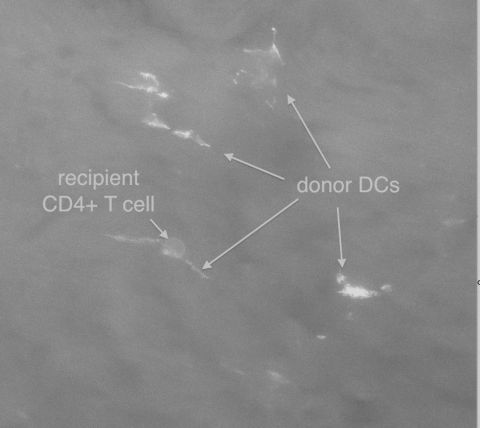Potential Contributions to the Direct Pathway by Donor Dendritic Cells at Vascularized Graft
CSB, Massachusetts General Hospital, Boston, MA
Transplantation Research Center, Renal, Brigham and Women's Hospital, Boston, MA
Wellman Center, Dermatology, Massachusetts General Hospital, Boston, MA
Critical Care Medicine, Tokyo Medical University Hospital, Hchioji, Tokyo, Japan
Meeting: 2013 American Transplant Congress
Abstract number: C1166
It is widely known that resident dendritic cells (DC) in tissue, or donor DC (dDC), are able to traffic to the secondary lymphoid tissues of recipients, where they present alloantigens to recipient T cells.
We have now adapted the use of intravital microscopy (IVM) to track EYFP DC motility, morphology, and cell density in real-time as they migrate between the beating cardiac allograft and secondary lymphoid tissues via the systemic circulation. Using this system, we found that passenger dendritic cells of donor origin that are transferred within the cardiac allograft show distinct patterns of egress. Moreover, injections of various cells into recipients will allow us to investigate immunoimaging such as real time dynamic images of cellular cross-talk (i.e. between DCs and CD4+, CD8+ T cells). Our preliminary data using cardiac transplant model showed that both injected CD4+T cells and CD8+T cells (5 millions on Day 0) were detected at graft and dDC (EGFP) has already started cross-talking with CD4+T cells (red) right after reperfusion. 3-D pathological images also confirmed its finding.

Since dDC located at graft is exposed to host cells right after reperfusion and several dDC from isograft were still detected by IVM after 14 days of survival, our recent findings described above could provide us the following possibilities; 1) dDC has already been activated by IRI, 2) dDC is the most potent antigen presenting cells, and 3) dDC might play an emering role as a bridge between innate immunity and alloimmunity in cardiac transplant model. It would provide us to investigate new innovative therapeutic strategies to minimize IRI after transplantation.
To cite this abstract in AMA style:
Ueno T, Yeung M, Jun K, McGrath M, Silva NDa, Ikeda T, Najafian N, Sylvie B, Brown D, Yun A, Weissleder R, Sayegh M. Potential Contributions to the Direct Pathway by Donor Dendritic Cells at Vascularized Graft [abstract]. Am J Transplant. 2013; 13 (suppl 5). https://atcmeetingabstracts.com/abstract/potential-contributions-to-the-direct-pathway-by-donor-dendritic-cells-at-vascularized-graft/. Accessed December 1, 2025.« Back to 2013 American Transplant Congress
